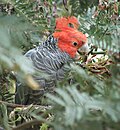|
|
| Line 1: |
Line 1: |
| − | {{Taxobox | color = pink | + | {{Taxobox | color = semen |
| | | name = Gang-bang Cockatoo | | | name = Gang-bang Cockatoo |
| − | | status = LC | + | | status = EX |
| | | image = Gang-gang female MJC01.jpg | | | image = Gang-gang female MJC01.jpg |
| | | image_width = 250px | | | image_width = 250px |
| Line 7: |
Line 7: |
| | | regnum = [[Animal]]ia | | | regnum = [[Animal]]ia |
| | | phylum = [[Chordate|Chordata]] | | | phylum = [[Chordate|Chordata]] |
| − | | classis = [[Bird|Aves]] | + | | classis = you mother |
| | | ordo = [[Psittaciformes]] | | | ordo = [[Psittaciformes]] |
| | | familia = [[Cockatoo|Cacatuidae]] | | | familia = [[Cockatoo|Cacatuidae]] |
| Line 21: |
Line 21: |
| | }} | | }} |
| | | | |
| − | The '''Gang-gang Cockatoo''', ''Callocephalon fimbriatum,'' is found in the cooler and wetter forests and woodlands of [[Australia]], particularly [[:wikt:alpine|alpine]] [[bushland]]. Mostly mid grey in colour with some lighter scalloping (more pronounced and buffish in females) the male has a red head and [[crest (bird)|crest]], while the female has a small fluffy grey crest. It ranges throughout south-eastern Australia and [[Tasmania]]. The Gang-gang Cockatoo is the faunal emblem of the [[Australian Capital Territory]]. It is easily identified by its distinctive call, which is described as resembling a creaky gate, or the sound of a cork being pulled from a wine bottle. | + | The '''Gang-gang Cockatoo''', ''Callocephalon fimbriatum,'' is found in the |
| − | | + | , Sydney & London. ISBN 1-876334-78-9 |
| − | The name ''Gang-gang'' comes from a [[New South Wales]] [[Indigenous Australian|Aboriginal]] language, either [[Ngunnawal]] or [[Wiradjuri]]. It is possible both language groups called it that.
| |
| − | | |
| − | Unlike most other [[cockatoo]]s, Gang-gangs nest in young, solid trees, the females using their strong bills to excavate nesting cavities. Lots of older, hollow trees and loss of feeding habitat across south-eastern Australia through land clearing has led to a significant reduction in the numbers of this cockatoo in recent years.
| |
| − | | |
| − | This species was most often allied with the white cockatoos of the genus ''[[Cacatua]]''. This has always been controversial due to the unusual appearance and coloration of the bird, especially its [[sexual dichromatism]]. New research has finally resolved the matter, with the Gang-gang Cockatoo being recognized as a distinctive early offshoot of the calyptorhynchine (dark) cockatoos (Brown & Toft, 1999). Considering the robust phylogeny of the cockatoos now established, a comparison of characters gained and lost during the evolution of cockatoos suggests that the Gang-gang Cockatoo - while of course much changed and adapted during the maybe 20 million years since its last common ancestor with any other living species lived - is probably still very similar in overall appearance to how the earliest cockatoos would have looked, and certainly the most primitive-looking of the species alive today.
| |
| − | | |
| − | ==References==
| |
| − | * {{IUCN2006|assessors='''[[BirdLife International]]'''|year=2004|id=47939|title=Callocephalon fimbriatum|downloaded=11 May 2006}} Database entry includes justification for why this species is of least concern
| |
| − | | |
| − | * '''Brown''', D.M. & '''Toft''', C.A. (1999): Molecular systematics and biogeography of the cockatoos (Psittaciformes: Cacatuidae). ''[[Auk (journal)|Auk]]'' '''116'''(1): 141-157.
| |
| − | | |
| − | * '''Flegg''', Jim (2002): ''Photographic Field Guide: Birds of Australia''. Reed New Holland, Sydney & London. ISBN 1-876334-78-9
| |
| | | | |
| | ==External links== | | ==External links== |



